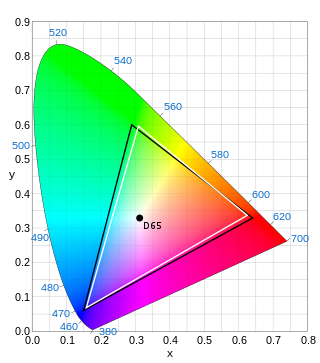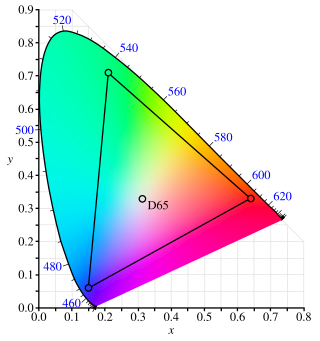Gamma correction or gamma is a nonlinear operation used to encode and decode luminance or tristimulus values in video or still image systems. Gamma correction is, in the simplest cases, defined by the following power-law expression:

Chroma subsampling is the practice of encoding images by implementing less resolution for chroma information than for luma information, taking advantage of the human visual system's lower acuity for color differences than for luminance.

ITU-R Recommendation BT.601, more commonly known by the abbreviations Rec. 601 or BT.601 is a standard originally issued in 1982 by the CCIR for encoding interlaced analog video signals in digital video form. It includes methods of encoding 525-line 60 Hz and 625-line 50 Hz signals, both with an active region covering 720 luminance samples and 360 chrominance samples per line. The color encoding system is known as YCbCr 4:2:2.

YCbCr, Y′CbCr, or Y Pb/Cb Pr/Cr, also written as YCBCR or Y′CBCR, is a family of color spaces used as a part of the color image pipeline in video and digital photography systems. Y′ is the luma component and CB and CR are the blue-difference and red-difference chroma components. Y′ is distinguished from Y, which is luminance, meaning that light intensity is nonlinearly encoded based on gamma corrected RGB primaries.

sRGB is a standard RGB color space that HP and Microsoft created cooperatively in 1996 to use on monitors, printers, and the World Wide Web. It was subsequently standardized by the International Electrotechnical Commission (IEC) as IEC 61966-2-1:1999. sRGB is the current defined standard colorspace for the web, and it is usually the assumed colorspace for images that are neither tagged for a colorspace nor have an embedded color profile.

The Adobe RGB (1998) color space or opRGB is a color space developed by Adobe Inc. in 1998. It was designed to encompass most of the colors achievable on CMYK color printers, but by using RGB primary colors on a device such as a computer display. The Adobe RGB (1998) color space encompasses roughly 50% of the visible colors specified by the CIELAB color space – improving upon the gamut of the sRGB color space, primarily in cyan-green hues. It was subsequently standardized by the IEC as IEC 61966-2-5:1999 with a name opRGB and is used in HDMI.

YPbPr or Y'PbPr, also written as YPBPR, is a color space used in video electronics, in particular in reference to component video cables. YPBPR is gamma corrected YCBCR color space ; the two are numerically equivalent but YPBPR is designed for use in analog systems while YCBCR is intended for digital video. The EOTF may be different from common sRGB EOTF and BT.1886 EOTF. Sync is carried on the Y channel and is a bi-level sync signal, but in HD formats a tri-level sync is used and is typically carried on all channels.
Relative luminance follows the photometric definition of luminance including spectral weighting for human vision, but while luminance is a measure of light in units such as , Relative luminance values are normalized as 0.0 to 1.0, with 1.0 being a theoretical perfect reflector of 100% reference white. Like the photometric definition, it is related to the luminous flux density in a particular direction, which is radiant flux density weighted by the luminous efficiency function y(λ) of the CIE Standard Observer.
In video, luma represents the brightness in an image. Luma is typically paired with chrominance. Luma represents the achromatic image, while the chroma components represent the color information. Converting R′G′B′ sources into luma and chroma allows for chroma subsampling: because human vision has finer spatial sensitivity to luminance differences than chromatic differences, video systems can store and transmit chromatic information at lower resolution, optimizing perceived detail at a particular bandwidth.

Rec. 709, also known as Rec.709, BT.709, and ITU 709, is a standard developed by ITU-R for image encoding and signal characteristics of high-definition television.

ITU-R Recommendation BT.2020, more commonly known by the abbreviations Rec. 2020 or BT.2020, defines various aspects of ultra-high-definition television (UHDTV) with standard dynamic range (SDR) and wide color gamut (WCG), including picture resolutions, frame rates with progressive scan, bit depths, color primaries, RGB and luma-chroma color representations, chroma subsamplings, and an opto-electronic transfer function. The first version of Rec. 2020 was posted on the International Telecommunication Union (ITU) website on August 23, 2012, and two further editions have been published since then.

The hybrid log–gamma (HLG) transfer function is a transfer function jointly developed by the BBC and NHK for high dynamic range (HDR) display. It's backward compatible with the transfer function of SDR. It was approved as ARIB STD-B67 by the Association of Radio Industries and Businesses (ARIB). It is also defined in ATSC 3.0, Digital Video Broadcasting (DVB) UHD-1 Phase 2, and International Telecommunication Union (ITU) Rec. 2100.
Standard-dynamic-range (SDR) video is a video technology which represents light intensity based on the brightness, contrast and color characteristics and limitations of a cathode ray tube (CRT) display. SDR video is able to represent a video or picture's colors with a maximum luminance around 100 cd/m2, a black level around 0.1 cd/m2 and Rec.709 / sRGB color gamut. It uses the gamma curve as its electro-optical transfer function.

ICTCP, ICtCp, or ITP is a color representation format specified in the Rec. ITU-R BT.2100 standard that is used as a part of the color image pipeline in video and digital photography systems for high dynamic range (HDR) and wide color gamut (WCG) imagery. It was developed by Dolby Laboratories from the IPT color space by Ebner and Fairchild. The format is derived from an associated RGB color space by a coordinate transformation that includes two matrix transformations and an intermediate nonlinear transfer function that is informally known as gamma pre-correction. The transformation produces three signals called I, CT, and CP. The ICTCP transformation can be used with RGB signals derived from either the perceptual quantizer (PQ) or hybrid log–gamma (HLG) nonlinearity functions, but is most commonly associated with the PQ function.
ITU-R Recommendation BT.2100, more commonly known by the abbreviations Rec. 2100 or BT.2100, introduced high-dynamic-range television (HDR-TV) by recommending the use of the perceptual quantizer (PQ) or hybrid log–gamma (HLG) transfer functions instead of the traditional "gamma" previously used for SDR-TV.
The perceptual quantizer (PQ), published by SMPTE as SMPTE ST 2084, is a transfer function that allows for HDR display by replacing the gamma curve used in SDR. It is capable of representing luminance level up to 10000 cd/m2 (nits) and down to 0.0001 nits. It has been developed by Dolby and standardized in 2014 by SMPTE and also in 2016 by ITU in Rec. 2100. ITU specifies the use of PQ or HLG as transfer functions for HDR-TV. PQ is the basis of HDR video formats and is also used for HDR still picture formats. PQ is not backward compatible with the BT.1886 EOTF, while HLG is compatible.
High-dynamic-range television is a technology that improves the quality of display signals. It is contrasted with the retroactively-named standard dynamic range (SDR). HDR changes the way the luminance and colors of videos and images are represented in the signal, and allows brighter and more detailed highlight representation, darker and more-detailed shadows, and a wider array of more intense colors.
This article is about the transfer functions used in pictures and videos and describing the relationship between electrical signal, scene light and displayed light.

The EBU colour bars is a television test card used to check if a video signal has been altered by recording or transmission, and what adjustments must be made to bring it back to specification. It is also used for setting a television monitor or receiver to reproduce chrominance and luminance information correctly. The EBU bars are most commonly shown arranged side-by-side in a vertical manner, though some broadcasters – such as TVP in Poland, and Gabon Télévision in Gabon – were known to have aired a horizontal version of the EBU bars.


















